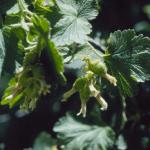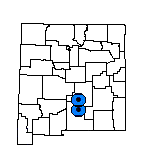Ribes mescalerium (Mescalero Currant)
| USFWS | State of NM | USFS | BLM | Navajo Nation | State Rank | Global Rank | R-E-D Code | NMRPTC Status | Strategy Status |
|---|---|---|---|---|---|---|---|---|---|
| S4? | G4? | 1-1-2 | R | SS |
| Overall Conservation Status | Documented Threats | Actions Needed |
|---|---|---|
| WEAKLY CONSERVED | No information |
Determine rarity. Study effects of logging and forest fires |
Carter, J.L. 1997. Trees and shrubs of New Mexico. Johnson Books, Boulder, Colorado.
Correll, D.S. and M.C. Johnston. 1970. Manual of the vascular plants of Texas. Texas Research Foundation, Renner, Texas.
*Vines, R.A. 1960. Trees, shrubs and woody vines of the Southwest. University of Texas Press, Austin.
Powell, A.M. 1988. Trees and shrubs of Trans-Pecos Texas. Big Bend Natural History Association, Alpine, Texas.
For distribution maps and more information, visit Natural Heritage New Mexico






